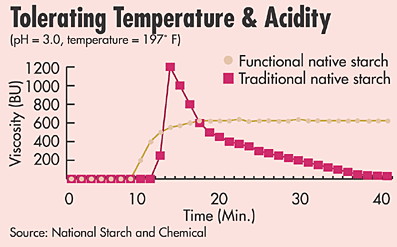The Novation® line of starches, available from National Starch and Chemical, Bridgewater, N.J., offers formulators a new tool in the development of organic foods. “The organic industry needs to reach out to mainstream consumers and offer them products that meet the flavor, texture and appearance of foods to which they are accustomed,” says Joe Lombardi, marketing manager.
The U.S. organic foods market is experiencing significant growth, especially after the USDA finalized new regulations last summer. The guidelines give four different labeling categories: 100% organic, organic (95% of the ingredients must be organic), made with organic (70-95% of the ingredients must be organic) and products with less than 70% organic ingredients (which will be allowed to list organic items in the ingredient panel only). The organic ingredients used in the claims need to be sourced from the USDA’s National List. This list is approved by the Organic Materials Review Institute (omri.org), Eugene, Ore., a technical review group for the USDA. Currently, the Novation line of food starches is the only approved brand name in its category and the company is pursuing 100% organic certification.

No Change in the Process
Another advantage of Novation starches is that, because they are designed to perform in various manufacturing processes, mainstream (non-organic) food processors can substitute them for the modified food starches they now use—without changing any of their manufacturing systems. Novation products can be substituted for currently used modified starches at equivalent levels, while still fitting within a product's manufacturing and distribution processes. This natural compatibility saves manufacturers the time and costs of having to retrofit equipment.The functional, native starches can be used across a wide spectrum of foods, such as soups, sauces, gravies, salad dressings, yogurts and dairy products, and meat products.
“Because it's a technology and not a type of raw starch, we can use the process on virtually any native starch base that we choose,” explains Lombardi. The plant source of starch used depends on the unique attributes desired. The company offers various functional native starches derived from corn for many applications, including pie fillings; tapioca (for blander applications); potato (high viscosity applications); and waxy rice (increased freeze/thaw stability). The starches are offered in powder form, with cold water-soluble and hot/cook-up versions; they can be used in quantities compatible with modified food starches.

For more information: Joe Lombardi at 908-707-3709 joe.lombardi@nstarch.com • www.novationstarches.com National Starch and Chemical Write in 215